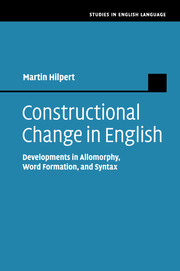Book contents
1 - Introduction
Published online by Cambridge University Press: 05 May 2013
Summary
Constructions and language change
This book outlines an approach to language change from the perspective of Construction Grammar. The idea of ‘constructional change’ will be developed as a new way of looking at diachronic processes in language. The following chapters present several case studies from the history of English in order to illustrate what processes of change come together in the development of grammatical constructions, and how the adoption of a constructional perspective can deepen our understanding of grammatical change. Naturally, an undertaking of this kind has to justify why a new term – constructional change – is introduced to group together formal and functional processes of change that affect constructions. As will be discussed, many of these are in fact quite well understood individually, and some of them are already grouped together under the heading of grammaticalization (Hopper and Traugott 2003). In what cases should we speak of constructional change rather than use established terminology? This book is an attempt to formulate a comprehensive answer to this question and to offer example analyses in which the theoretical concept of a changing, developing construction yields a shift in perspective, thus revealing issues that were previously not amenable to analysis.
The general idea of constructional change is of course not new. In fact, it has gained fairly wide currency over the past years and work on its theoretical status, similar in spirit to the present study, is underway (Bybee 2010, Trousdale 2010). Much recent work on language change, especially research with a functional orientation, focuses on the level of grammatical constructions (Bergs and Diewald 2008, Traugott and Trousdale 2010).
- Type
- Chapter
- Information
- Constructional Change in EnglishDevelopments in Allomorphy, Word Formation, and Syntax, pp. 1 - 25Publisher: Cambridge University PressPrint publication year: 2013

